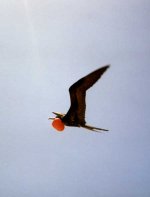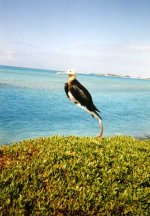librarygirl
Member
Hi there. I was lucky enough to spend 4 days last week in the gorgeous town of Todos Santos, on the Pacific side of Baja California. It's about a 2 hour drive from the airport at Los Cabos. We were there primarily to view the grey whales, which are migrating right now. That was incredible, of course.
But the big surprise was how many cool birds we got to see. The place we stayed at had a lagoon which was separated from the ocean by a narrow beach. We saw a ton of birds, ne blue heron, egrets, coots, various duck-like things we didn't identify, cormorants...by far, the most incredible thing was seeing the frigatebirds. Most of the ones we saw circling all day appeared to be females. We saw a male with an all-black head and red throat pouch (uninflated, unfortunately), but only once.
ne blue heron, egrets, coots, various duck-like things we didn't identify, cormorants...by far, the most incredible thing was seeing the frigatebirds. Most of the ones we saw circling all day appeared to be females. We saw a male with an all-black head and red throat pouch (uninflated, unfortunately), but only once.
The females would circle all day long near the cliffs adjacent to the beach. They would do this weird behavior very often, and I have looked everywhere but can't find a source telling me what it was and why they do it. Basically, they'd be gliding, circling on thermals. Then they would dive down a little way while doing something that looks like a fast shrugging of the shoulders and head. This motion was about 2 seconds long, maybe. Then they'd start to swoop back up and while they did that they swished their forked tail feathers from side to side quite briskly.
Does anyone know what that is all about? Also, do you know which kind of Frigatebird is native to that region? I am really new to the whole bird thing so I am not very knowledgeable yet. This Baja trip really made me eager to learn and see much more.
I'm studying to be a librarian and I'm ashamed I have not found the answer to my behavior question yet! Thanks in advance for your help.
{edited to add: we also saw some glossy ibis!}
But the big surprise was how many cool birds we got to see. The place we stayed at had a lagoon which was separated from the ocean by a narrow beach. We saw a ton of birds,
The females would circle all day long near the cliffs adjacent to the beach. They would do this weird behavior very often, and I have looked everywhere but can't find a source telling me what it was and why they do it. Basically, they'd be gliding, circling on thermals. Then they would dive down a little way while doing something that looks like a fast shrugging of the shoulders and head. This motion was about 2 seconds long, maybe. Then they'd start to swoop back up and while they did that they swished their forked tail feathers from side to side quite briskly.
Does anyone know what that is all about? Also, do you know which kind of Frigatebird is native to that region? I am really new to the whole bird thing so I am not very knowledgeable yet. This Baja trip really made me eager to learn and see much more.
I'm studying to be a librarian and I'm ashamed I have not found the answer to my behavior question yet! Thanks in advance for your help.
{edited to add: we also saw some glossy ibis!}
Last edited:





